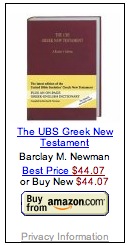The Kind of Stuff I Find Nowhere Else

No, I didn't partake...
Trans. Abbrev. Conf.
Abbreviations are a helpful thing. When talking about Bibles, it's much easier to simply write "NLT" than New Living Translation every I want to reference it.
I don't always remember to do it, but when writing a blog entry that refers to a translation, I try to write it out the first time I reference it along with the abbreviation in parentheses which I simply use from that point forward.
With the advent of the New American Standard Bible in the 1970's we got the four-letter abbreviation, "NASB," followed by the NKJV, NRSV and now the HCSB (which we have recently heard is going to soon be reduced to simply the three-letter "CSB").
A lot of us who discuss translations regularly take these abbreviations for granted, but surely they cause confusion now and then to the unititiated.
So as excited as I was to see the release of the New English Translation of the Septuagint (which in my opinion is the first significant English translation of the Septuagint since Brenton's of 1851), I was very disappointed in its acronym: NETS. And yes, that IS the acronym as it is set by the publishers on the copyright page with the statement:
"A New English Translation of the Septuagint may be quoted in nonsalable media (such as church bulletins, orders of service, liturgies, newsletters, etc.) without inclusion of a copyright notice, but the abbreviation NETS must appear at the end of each quotation."
What's the problem with "NETS"? Well, to me, it is way too close to NET (New English Translation) which was already too close to NEB (New English Bible).
NEB = New English Bible
NET = New English Transltion
NETS = New English Translation of the Septuagint
And, of course, none of these three translations have anything to do with the others.
I wonder where all the creativity has gone in naming translations. I also wonder if the NET Bible was even on the radar of the NETS editors when they came up with the name. Although I personally consider the NET Bible a major translation (and my review is finally in the works), it has not received the exposure it deserves because it (to my knowledge) is only available through mail order.
Some might feel the nearness of the acronyms to the NEB is a non-issue because it is now nearly four decades from its last edition before the REB. However, I still occasionally come across NEW reference books that refer to the NEB--sometimes in EXCLUSION to the REB which has been available for almost two decades!
So, I see room for all kinds of abbreviation confusion, especially between the NET and NETS. And one would think that with 26 letters of the alphabet, we could come up with a few more unique combinations!
Blum on the HCSB at Anwoth

Blum is incredibly transparent about disagreements among the translators and even the publishers. Also, Blum goes to great length to distinguish the HCSB from other translations and combat the notion that this is a "Baptist Bible" (Blum himself is not Baptist). You must read the entire interview, but here are some of the more surprising elements about the HCSB and Blum that were revealed:
- A second edition of the HCSB will be released in 2009.
- Why "beer" is used instead of "strong drink."
- When the project first started by Arthur Farstad, there were parallel tracks for the HCSB in which there were to be two New Testaments, one based on the Majority Text and one based on the Nestle-Aland text. The Majority Text project was dropped after the death of Farstad.
- Southern Baptists (does he mean Lifeway here?) tried to BUY the NASB from the Lockman Foundation three times--and it almost went through!
- We finally get a better understanding of the relationship of the HCSB to the Logos21/Living Water Gospel of John.
- Blum explains the complicated history behind the name "Holman Christian Standard Bible" and reveals other names considered. Every name including the current one has legal issues, though.
- According to Blum, "Holman" is already being downplayed in the logo and will soon disappear altogether leaving the designation simply "CSB."
- Mounce sent Blum an email stating that the HCSB is the first translation to get John 3:16 right. (I think I said that, too, a while back!)
- Currently, the HCSB uses the designation "Yahweh" instead of the traditional "LORD" (all caps) 75 times. In the 2009 revision, that number will grow to 400.
- Awkward terms like "deluge" and "atmospheric domains" will NOT appear in the 2009 revision.
- Blum explains the decision to go with the half brackets around some words that are added for clarity, but admits he was not in favor of doing it.
- The HCSB translators hate red-letter editions, but publishers love it.
- Farstad was not a Baptist but was a Brethren. Blum is Presbyterian. Only about 1/3 of the translators were Southern Baptist. This hardly justifies the HCSB's reputation as the "Baptist Bible."
- Blum claims that the HCSB is outselling the ESV two to one.
- Agrees that the HCSB website is hard to use.
Good stuff. Really good stuff.
The Best Bible Translation
I do not really believe that there is a BEST translation out there for all people, preferring to ask, “Best for what?”
When studying the Bible, my habit is to start with the original languages (especially with the NT as my Greek is much stronger than my Hebrew), and first work out my own translation. I admit that I don't always do this, especially if I'm about to teach a "well known" passage--that is, one that I've taught before. But when I have the time, I find great value with beginning with the original languages, and then referencing English translations as well. I find that the nuances between translations help me better understand the original languages themselves, especially if there’s great difference from my own translation.
My Core Translations. I have a “core” of first-level English translations I refer to which I believe span the range from formal to dynamic. On the formal side, I will read from the New American Standard Bible (NASB), which is also the Bible in which I still make my “permanent” notations in its wide margin. In the median range, I consult both the Holman Christian Standard Bible (HCSB) and Today's New International Version (TNIV), two very good recent translations, but with different approaches to translating gender in some passages. On the dynamic range, I take a look at the second edition of the New Living Translation (NLT). The scholarship is very solid in this translation, and sometimes its dynamic flavor actually brings out the meaning of the passage better than more literal translations.
Secondary Translations. If I have time, I have a secondary tier of translations that I will consult from including the New English Translation (NET or NET Bible), New Revised Standard Version (NRSV), English Standard Version (ESV), the TANAKH from the Jewish Publication Society (JPS), Revised English Bible (REB), King James Version (KJV) and occasionally a few others. I don't have a large KJV constituency in the groups I teach, but if I did, I would probably move it to the core translations I look at. As for the NET Bible, I like the notes so much that I often consult them early when studying a passage, sometimes before I hit commentaries and other reference works in order to get a quick history of textual issues and interpretation.
Physical vs. Electronic. When I study a passage, I don’t have dozens of Bibles in front of me as I tend to use parallel panes in Accordance for a lot of this work. I may have a Greek NT in front of me because I sometimes like to make notes about the grammar or a word or phrase in the margin. Interpretive and explanatory notes I’ll write down in the wide margin NASB that I’ve already mentioned. And I might also have a TNIV with me since in the last year and a half I primarily have begun to use this when teaching or preaching in public. The margins in my TNIV are much more narrow than those in my NASB, so I can add a few notations, but I have to be selective.
Primary Bible Recommendations. When people ask me to recommend a translation, currently I am only recommending the HCSB, NLT and TNIV as a primary Bible, although I do suggest getting a good formal equivalent Bible such as the NASB to read in parallel. These three that I recommend also happen to be the three that I mostly use in public. Most of the time I teach out of the TNIV. However, sometimes in my preparation, I find a passage in the HCSB that simply seems to be rendered more accurately and I'll opt for that. When speaking in front of groups that I believe may include those who are not Christians or those with less background in the Bible, I often opt for the NLT because it is much closer to conversational English than other translations. For Catholic believers, I recommend the New Jerusalem Bible (NJB) over the New American Bible (NAB). The NRSV has the widest collection of Intertestamental books of any translation, with which more Christians should acquaint themselves.
Best for Children. I still believe the Good News Translation (GNT), especially one with the line drawing illustrations, is the best translation for a child who is just learning to read. Sadly, though, these are becoming more difficult to find.
Favorite for Reading. My favorite Bible strictly for reading is the REB, which is undoubtedly the best literary translation of the Bible since the KJV, but without the archaic baggage.
For more information, consult my series on my "Top Ten Bible Versions."
Note: This post is an expansion of a comment I left over at Said at Southern.
The Forbidden Fruit Was Actually A Papaya
“So she took some of the fruit and ate it.
Then she gave some to her husband,
who was with her, and he ate it, too.”
(Gen 3:6 NLT)

Yesterday, in our Bible study class, I taught on Genesis 3. During my preparation I came across an interesting bit of trivia--how the apple became associated with the forbidden fruit. You know what I'm talking about right? In most popular conceptions of the story, it's an apple that Adam and Eve partake of in violation of God's command, resulting in their fall from innocence and banishment from paradise. I believe I even had a Bible story book or two as a child that specifically said they ate an apple. But as soon as I could read the story for myself, I found out that nowhere is any specific fruit mentioned, let alone an apple (of course, I was also disappointed while still quite young when I couldn't find anywhere in the Bible that Jesus' cross was made from a dogwood tree). So how did an apple get connected to the story? Well it seems that the Latin word for apple is malum, while the word for evil is malus. The phonetic connection between the two words became the key to the association down through the ages. So much for keeping the doctor away...
Ethical Philosophy Selector
Here are my results:
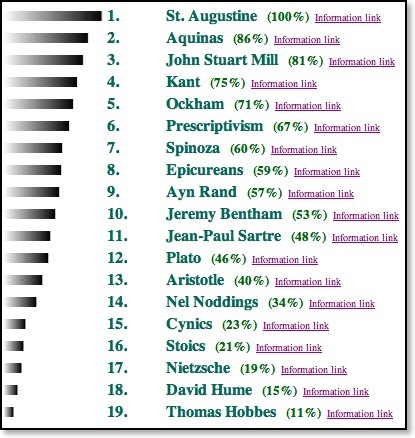
Interesting results. I would have never thought I'd agree with Augustine 100%, although I do like some of his thought. Interesting also that Aquinas came in second place.
Feel free to take the quiz yourself and leave your results in the comments.
HT: Iyov, Peter Kirk.
Eleven Ways to Care for Your New Bible
Here are a few tips for taking care of your new Bible so that it will be of service for years and decades to come.
- Unpack it carefully. It's cold this time of year. So if your new Bible has been sitting on a mail truck for the last few hours or even days, be very careful when you first open it. Most Bibles, even those with sewn bindings, use glue to some extent. Cold weather can make that glue brittle. Opening a Bible that's been in the cold can instantly create a permanent crease in the spine where the glue will actually break. If your Bible has been out in the cold, it might be best to let it come to room temperature before laying it open flat. When examining your new Bible for the first time, gently and slowly open it.
- Inspect it carefully. All Bible publishers have generous return policies if you find a serious defect in your Bible. Be careful with gilded page edges as these will probably be stuck together. I've seen pages torn from being separated too quickly. There are actually methods for separating multiple pages at a time such as gently bending your Bible one way and then the other to let the pages separate. Also look for printing flaws. I've seen it all. Missing pages, missing books of the Bible, maps out of order, and printing defects. For whatever reason I regularly end up with printing defects in a new Bible in which a page has been improperly cut on a corner and is folded up into the Bible. Sometimes two pages were never separated. If you decide to keep a Bible like this rather than returning it, don't tear the pages apart, but use a sharp pair of scissors to separate them. Then, if the corner of the page is greater than the other pages, use the scissors to trim the page slightly shorter than the other pages. Any page sticking out will become ragged over time, but cutting the page a bit short will solve this problem.
- Use your hands. The best method for softening a bonded leather or genuine leather Bible is to simply hold it in your hands regularly. The natural oil from your hands (the stuff that leaves fingerprints everywhere) is what softens Bible leather. Keeping your Bible in a Bible cover/case at all times is actually one of the worst things you can do for a Bible, although many people mistakenly believe they are taking care of them this way. I've seen leather Bibles start to crack along the edges of spine because they were kept in protective Bible covers and never allowed to soften from regular use in someone's hands. If you live in an area with lots of bad weather and need to use a protective Bible cover, take it out of the cover when you are actually reading and studying from it. By the way, number of the newer imitation leather covers come already feeling so soft, they seem to already have seen years of use--kind of like buying pre-faded jeans. But no one really knows yet how these new kinds of imitation leathers will hold up after many years of use. If you definitely want the Bible to be around for a long time, select a leather cover.
- Keep your Bible out of the rain. You think this would be a no-brainer, but not necessarily so. If it's raining and you need to carry your Bible, try to hide it under a jacket or put it in a bag or even a Bible case (but take it out when you use it--see #3). Rain drops will cause those ugly looking spots on the silver or gold gilding your Bible has on its page edges. If you get caught in the rain and have no protection for your Bible, hold it spine up to keep water off the paper as much as possible. Not only does rain cause the aforementioned spots, it also will seep into the pages and cause wrinkles and possibly even create smears of ink if you've taken notes in your Bible.
- Don't leave your Bible on the dashboard of your car. When I see a Bible on someone's dash on Thursday in some parking lot, I know that its probably been sitting there since Sunday and the owner hasn't been reading it. More seriously, a dashboard is one of the worst places to keep your Bible. The windshield intensifies the rays of the sun and will dry out the leather. In the hot summer time, this is about like putting your Bible in an oven. In the wintertime, not only can it dry it out, but you also run the risk of hardening any glue in the binding, causing a break when you go to use it next (see #1).
- Use the right kind of pens and highlighters for taking notes. Never use wet highlighters or felt tip or fountain pens in your Bible as this ink will bleed through the thinner than normal pages. Instead, use dry wax highlighters that can be found in most Christian bookstores and some office supply stores. And for writing, employ a pen that uses archival ink such as the Pigma Micron series. These can be purchased at most arts and craft stores and on the internet.
- Tie off the end of your ribbon marker. Don't do this immediately, but if your ribbon marker starts to fray (most usually will eventually), tie the end of it off in a knot and it won't get any worse.
- Don't bend your cover over backwards. Not only will the librarian tell you this is a no-no for library books, I'll tell you that you should never do this to your Bible. I often see preachers bending a Bible all the way over to where the top and bottom covers are touching. This stretches the spine of your Bible and can possibly break it. This often leads to pages falling out, even from Bibles that have sewn bindings. Most Bibles are designed to lay open in one hand and feel limp. But it shouldn't be pushed back any further than this.
- Unfold curled pages. If the corner of a page folds over for whatever reason, unfold it as soon as possible. Inspect your Bible for this regularly because the turned down corners may eventually crack and come off. I've seen many missing page corners in older books and Bibles. Of course, it should go without saying to never fold over the corner of a page to mark your place. This is what a marker ribbon is for. Or use some other kind of bookmark.
- Don't stuff a bunch of material between your Bible's pages. Don't clutter up your Bible with 18 weeks' worth of previous church bulletins or even your current Bible study guide. The spine of your Bible was designed to support the number of pages within your Bible and that's it. Cramming a bunch of extra stuff in there increases your risk of breaking the spine. The librarian's rule is to mark your place with nothing thicker than a sheet of paper. Basic cardstock bookmarks are fine as well.
- Protect Your Bible from pets and very small children. You know how good that new leather smells? It smells even better to your pet! I've seen quite a few Bible covers that had become partial puppy snacks. If you have a dog, especially one that's under a year old or one with a tendency to chew on leather, keep your Bible up high and out of reach when you aren't using it. Also, I've seen very young children take great delight in tearing out those thinner Bible pages. Also, a child may not know the proper way to carry a Bible, and may drag it around by the pages or one end of the cover. Obviously, this isn't good for the health of your Bible. The best bet if pets and toddlers are around is to simply keep it up high.
Most Bibles, especially those with leather covers, are designed for years and decades of use. Proper care of your Bible will create a cherished family heirloom as opposed to the uncared-for Bible that may sadly be tossed in the trash one day.
If you have other tips of your own, feel free to add them to the comments section.
TNIV Reference Bible: Hands On Review
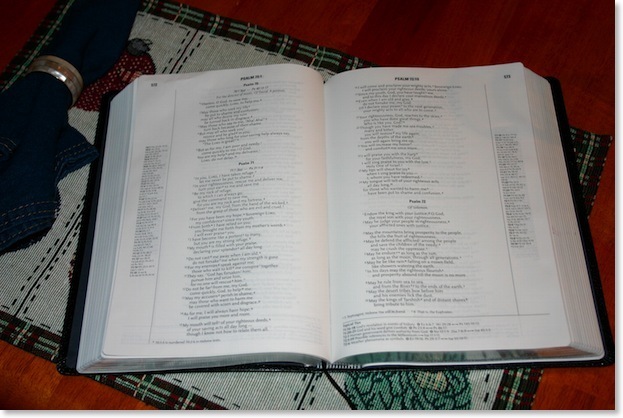
The official word from Zondervan states that the TNIV Reference Bible's official release date is January 2008. However, Christian Book Distributors is showing availability "on or about" December 10 (as of this writing, CBD did not have any copies yet). The TNIVRB has been a highly anticipated Bible for a number of reasons. The complete TNIV translation has only been in circulation for about two and a half years, andI started teaching primarily from it in the latter half of 2006. However, my greatest complaint at the time was that I couldn't find a copy of the TNIV that didn't draw attention to itself. That is, I couldn't find one that wasn't in neon colors, let alone one with a simple traditional look and feel. Further, I had difficulty find a text layout that I liked. I prefer a single-column text with wide margins for taking notes. Yet, at the time, I couldn't even find a single-column edition of the TNIV.
Then, in September of 2006, I laid eyes on proofs for two different editions of the TNIVRB that were being circulated by Zondervan. One contained the single column text which resulted in the final copy, but the other was a two-column text with cross references in the middle. I quickly cast my vote with the editors at Zondervan for the single-column text. Of course, I made a number of other suggestions, too, including those elusive wide-margins and also suggested moving the cross references to the inside of the page. Zondervan hasn't taken those two suggestions to heart yet, but I'll keep pushing. Besides my vote for the single-column text, the only other influence I feel I had on this edition was to press for a non-thinline edition. Unfortunately, this change in plans pushed the publication of the TNIVRB from October to now, and raised the price by about $5. Nevertheless, after quite a bit of waiting, the TNIVRB in its final form arrived in my mail today, a generous gift to me from my friends at Zondervan.
Zondervan aims the TNIVRB at pastors, students, and teachers. Further, their goal was to make the Bible high quality but sell it as low of a cost as possible to get it in as many "gatekeepers'" hands as possible. Therefore, the TNIVRB does not come in the tradition box that most high-end Zondervan Bibles include, but rather a cardstock slip cover. But as for the Bible itself, it appears to be very high quality. Currently, there's only one edition--black bonded leather--but that leather feels quite solid. More importantly, the binding is smyth-sewn so that the user won't have to worry about chunks of pages coming unglued.
I suppose I was most surprised about the size and weight of the Bible. As already mentioned, I lobbied Zondervan strongly not to make the TNIVRB a thinline Bible. After gaining support from other TNIV fans in the blogosphere, Zondervan announced in May of this year that the TNIVRB would measure in at about 1.25" thick. Well, when I got my copy in hand this evening, I immediately thought it looked thicker than that, so I measured it. I can tell you that the TNIVRB is actually about 1.5" thick, and I can't tell you how excited I am about that. This means thicker paper was used in the TNIVRB which will allow for less bleedthrough of text from underlying pages or personal notations.
Further, the TNIVRB feels good in the hand. It has just the right weight when holding it open, Billy-Graham-style in one hand. I like the TNIVRB because it both looks like a Bible and feels like a Bible! As shown in the picture above, it lays flat when laid on a surface. I don't mean that it merely stays open; it lays flat. Does it lay flat at Genesis 1? Well, not quite flat, but it stays open, which is more than I can say for my TNIV Study Bible that I wrestled with while teaching out of Genesis at church last Sunday. And I'm sure given some time, and once the cover absorbs the natural oil from being held in hand, that it will even lay flat at Gen 1.
As mentioned already, the cover is a black bonded leather. This is complemented by silver lettering and gilding of the pages' edge. The spine itself doesn't contain hard corners, but is semi-rounded which contributes to its look of high quality. The text on the spine is fairly simple. "Holy Bible" runs sideways, while "TNIV" and the current three-tiered Zondervan logo sit perpendicular and occupy the bottom 25% of the spine's area. A single black ribbon is included for marking one's place.
According to the publisher's website, the TNIVRB runs at 1,408 pages. Some pages, such as those designating the Old and New Testaments, and even sections of books within those categories have been seen in some other editions of the TNIV. But most of the TNIVRB is brand new layout. The main text pages themselves contain layout and text that looks anything but rushed. Frequent section headers help to set off pericopes, allowing the text to flow with plenty of free space. The main text font measures at 9 points and is adequate for a Bible of this size. In comparing pages in the final product to the proofs I saw in 2006, it may be that Zondervan slightly enlarged the type from the original concept as slightly less text appears on the pages in the published TNIVRB. Such changes are always welcome.
Thankfully, all text is BLACK, meaning no red lettering (I can hear the applause coming through the internet now).
Cross references run along the outer edge of the page and a new feature, "Topical Ties" run along the bottom. The Topical Ties treat subjects in the text along 700 or so categories. The reader is guided by markers demonstrating earlier or later texts which focus on the same subject. Unfortunately, an index to these topics is not included, but I would think it might be helpful if something like this were made available online.
Heavy note-takers, such as myself will find the TNIVRB mixed for note-taking. Some pages have a lesser number of cross references in the margin allowing for notes, but more "well-travelled" passages contain a full margin of notes that often spill over into the bottom of the page. Poetic sections, however, offer ample room for notations.
Nevertheless, between the cross references, Topical Ties, and parallel passage notations under section headings, the TNIVRB is the ultimate reference Bible. According to the slip cover, there are over 100,000 cross references alone. And Zondervan is claiming that the TNIVRB is the most comprehensive reference Bible available.
In the final analysis, the TNIVRB is the edition of the TNIV I wish I had been using from the very beginning. Nevertheless, late is better than never. Everything about it says this is a quality product, and while it isn't everything I finally want in an edition of the TNIV (I'm still holding out for wide margins), it will replace my TNIV Study Bible as my public TNIV of choice. I know a lot of people have been waiting for this Bible, and I'm glad to say that there are no final "gotchas." The TNIVRB is everything it was promised to be. I can readily recommend it to anyone wanting a regular reference edition of the TNIV, and it will be the edition that will receive the majority of my use.
The UBS Greek New Testament: A Readers Edition (A Hands-On, Comparative Review)
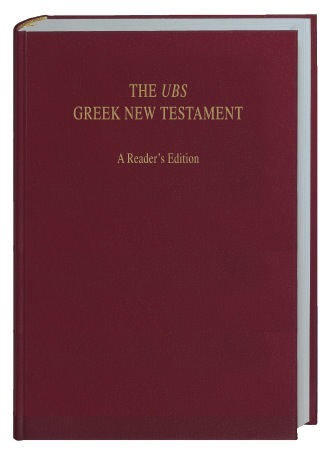
If you haven't read it already, I highly recommend that you see my earlier review of A Reader's Greek New Testament, 2nd Edition from Zondervan for a greater context in understanding this review. If you don't have time to do that, there are four things you should know right up front:
- The UBS Greek New Testament: A Reader's Edition (henceforth UBSRE), is similar in nature to Zondervan's A Reader's Greek New Testament (RGNT from this point forward) which has been published in two separate editions. The first was based upon the Greek text underlying the NIV, and the second is based upon the Greek text underlying the TNIV. All three of these New Testaments include a Greek text with a vocabulary apparatus at the bottom of the page containing definitions for all words that occur less than 30 times in the New Testament. The purpose of such an edition is to allow the reader with at minimum a basic foundation of Greek study to simply read the New Testament in Greek without having to constantly consult a lexicon for words not in one's working knowledge.
- As I explained in the previous review of the RGNT2, although I originally bought the Zondervan RGNT1 for the novelty of having the underlying NIV text, I actually found the volume quite useful, especially as a tool to throw into my book bag that I carry to church on Sundays. I found the idea of a Reader's New Testament in Greek with the vocabulary apparatus is extremely handy when I simply needed to consult the text and wasn't worried about text critical issue or didn't have the time to look up complete definitions in my BDAG lexicon.
- I was never fond of the italic text in the RGNT1, but it was bearable. I was extremely disappointed in the release of the RGNT2 in that although the text was changed to a non-italic font, it used a style with thinner character strokes that actually made the text more difficult to read in my opinion.
- Finally, about a year or so ago, a professor at a seminary extension contacted me wanting to know if I had heard whether the RGNT was being discontinued due to threat of a lawsuit from the United Bible Societies or the German Bible Society. I could not confirm any such lawsuit at the time or that the RGNT was being taken off the market (it was not). However, I did confirm from an off-the-record source recently that there was talk of an actual lawsuit, but it was deemed that since the standard eclectic Greek New Testament is based upon public domain ancient manuscripts, such a suit would not be able to stand up in court.
I'm happy to report that nothing ever came of the lawsuit talk. I would have greatly disappointed (especially in light of 1 Cor 6:1ff) if one Bible publisher had decided to sue another Bible publisher. Rather, the German Bible Society decided to create their own edition of a Greek New Testament similar to Zondervan's RGNT. The UBS version, however, is based upon the UBS Greek New Testament, fourth revised edition. The main features of the UBSRE include the following:
- Translation of all vocabulary items occurring 30 times or less in the New Testament at the bottom of the page
- Translations given according to context
- Definitions of idiomatic word combinations
- Grammatical analysis of all difficult verb forms
- Reader-friendly layout enabling the reader to transfer easily from text to dictionary and vice versa
- An appendix providing translations of all vocabulary items occurring more than 30 times in the New Testament
- The maps from the USB Greek New Testament.
I find it impossible to review the UBSRE without reference to Zondervan's RGNT, so I would prefer to offer a comparative review. From the outset, the immediate difference between these two is size. Although, both have about the same dimensions in height and width (both volumes are around 6" x 9"), the UBSRE is essentially twice as thick as the RGNT. Zondervan's product page for the RGNT states that it contains 576 pages, while the German Bible Society's product pages lists the UBSRE at 712 pages. So why is the UBSRE twice is thick as the competing product, even though it is less than 200 pages longer? Well, it has to do with the very thin paper and space-conserving format used in the RGNT, but I'll write more about that in a moment.

Admittedly, I like the soft, leather-like Italian DuoTone cover on the RGNT better than the hardcover binding of the UBSRE. The Zondervan product feels like a Bible, while the UBS edition feels like a book. The UBSRE is bound in what has become the signature burgundy cover with gold lettering that is used with most editions of the UBS Greek New Testament. However, I know that they also produce flexible covers, and I believe one would be appropriate for this edition.
Nevertheless, it's what's inside that counts, and this is where the UBS shines. I'll get to the layout issues in a moment, but first a few comments on the vocabulary apparatus. The apparatus itself is referred to in the introduction and on promotional materials as a "Running Greek-English Dictionary." The RGNT has this, too, of course, but the UBS edition may just be better. The definitions have been adapted from Barclay Newman's Concise Greek-English Dictionary of the New Testament contained in many UBS editions of the Greek New Testament. Of course, because of space, the definitions have been shortened based upon the context. Therefore, the the contextual decision may theoretically imply some amount of interpretation upon the editor's part, but this would not be any different from using Trenchard's glosses in the RGNT. Further, the running dictionary is not meant to replace use of a lexicon, but merely to allow quick access to the meaning of the text in certain contexts.
The UBSRE also breaks with the Zondervan editions in that it offers grammatical help on what the editors consider more difficult forms. So for instance, in John 1:42, both the UBSRE and the RGNT offer a definition for ἐμβλέψας. The RGNT: "ἐμβλέπω, I look at, consider." The UBSRE: "ἐμβλέπω aor act ptc m.s.nom, look straight at." For many readers, this extra grammatical information is going to be very helpful.
Like the RGNT2, the UBSRE also offers a mini glossary of Greek vocabulary words occuring more than 30 times (the ones that don't get listed with the text) in case the reader simply forgets what shoudl be a memorized word. But this is also a place where the two editions differ greatly. The word list in the RGNT2 is based on Warren C. Trenchard's Complete Vocabulary Guide to the Greek New Testament, so it's definitions are fairly short as one would expect. So, for instance, if one were to look up ἀγαθός in the RGNT2 appendix, would would find this entry: "ἀγαθός, ή, όν (102) good" (the numeral indicates how many times the word occurs in the Greek NT). However, because the definition appendix in the UBSRE bases its entries on Barclay Newman's dictionary, one will find a much more detailed entry: "ἀγαθός, ή, όν good; useful, satisfactory for one’s (its) purpose, fitting, beneficial; sound (of trees), fertile (of soil), happy (of days); in a moral sense upright, just; kind, generous; clear (of conscience); perfect, inherently good (of God); τὸ ἀγαθόν the good, what is good; what is right or upright; what is beneficial or advantageous; τὰ ἀγαθά goods, possessions; good things (Lk 16:25); good deeds (Jn 5:29)." That's quite a difference, but to be fair, one could argue that the RGNT2 offers the most essential information with the understanding that more detail can be derived from other resources. But again, for some readers, this extra information will be seen as quite helpful. I should also point out that the glossary in the RGNT only fills a little less than six pages, while the corresponding feature in the UBSRE fills 22 pages.
This leads me to what I believe is the most significant difference between the UBSRE and the RGNT2: layout and readability. The UBSRE is simply easier to read than the RGNT2. It's font is larger and the text is laid out leaving more white space on the page. Further, the running vocabulary list in the UBSRE runs in a two-column list which allows one to easily find the word he or she is looking for.
I took my own scans of each edition for this review rather than relying on the PDFs made available from each publisher. I thought this might give a fairer comparison between each edition. If the lines don't seem quite straight, it's from a less than perfect attempt on my part to hold the volume flat on my scanner.
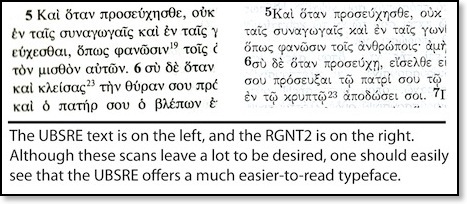
As I stated in the review of the RGNT2, part of the problem comes from my perception that Zondervan, normally a maker of quite excellent reference works, has an unhealthy preoccupation with thinline Bibles. Since the RGNT is a New Testament, someone in marketing or layout and design must have suggested than a thinline form factor be adopted. I'll be the first to admit, that the RGNT fits much more nicely in the hand than the UBSRE. However, this is strictly form over function. The UBSRE doesn't suffer from small print, cramped text, or near as much bleed through (which is even evident in the above samples) as the RGNT2. This issue is also apparent when you look at a full page spread of each edition.
[Note that neither of the scans below captured the full margins of either edition since my scanner space was smaller than a full page spread of either edition.]
First, the RGNT2 (click on the image to get a larger, more detailed view).
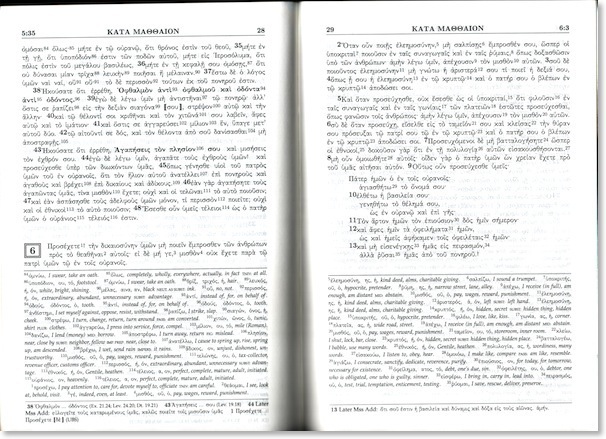
And now, the UBSRE (again, click on the image to see a larger, more detailed view):
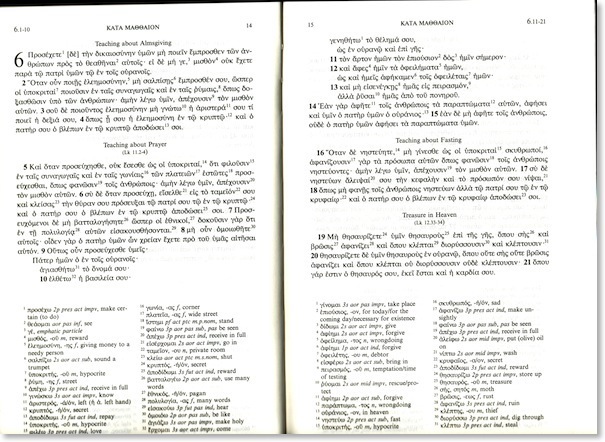
In my opinion, the UBSRE is much more inviting. Section headings separate pericopes, and parallel passages in other gospels are also noted. Of course some people prefer a straight text without section headings. If this is the case, the RGNT may be preferred to those readers. Finally, finding the definition of a word in the UBSRE is made much simpler and quicker with the two columns, rather than hunting through the paragraphed text of the RGNT's apparatus.
WHAT'S MISSING?
Not much. There's very little in the RGNT2 that's missing in the UBSRE. However, I felt the Scripture references for OT quotations in the RGNT2 were a very welcome addition, and one that the reader will not find in the UBSRE. The maps are a bit nicer in the RGNT2 than the standard UBS maps. The RGNT2 also added a few, sparse textual notes in addition those that referenced divergences from the UBS text. The reader of the UBSRE will still need to consult a more traditional edition to see textual issues.
Something should also be said about price. The UBSRE is significantly more expensive than the RGNT. I've stated for a long time that UBS prices were out of control, and this edition is no different. Even with discounts at places like Amazon or CBD, one can expect to pay about $20 more for the UBSRE over the price of the RGNT.
FINAL EVALUATION
Although initially, I was very excited about the release of the RGNT2 and its promised improvements over the first edition, I was quite disappointed in the final product. Yes, the thinline aspect of the RGNT2 might initially seem like a bonus over the twice-as-thick UBSRE, but in actual use, function simply wins out over form for me. The UBSRE is a better product because the designers of it did not choose to take shortcuts necessary to create a thinner form factor. From what I've heard, the RGNT had been greatly cutting into the sales of UBS/NA Greek New Testaments over the past few years, and the UBSRE is nothing less than a counter strike, and a significant one at that.
One last thing. If you read my review of the RGNT2, you'll remember I lamented that a ribbon marker was missing, in spite of the fact that one had been promised in early promotions, and even listed as a new feature on early shots of the box cover. Well, potential purchasers of the UBSRE will be glad to know that it does, in fact, come with a ribbon marker. Admittedly a minor detail, but handy for any reader, nonetheless.
A. T. Robertson on The Minister & His Greek New Testament

It ought to be taken for granted that the preacher has his Greek Testament. This statement will be challenged by many who excuse themselves from making any effort to know the Greek New Testament. I do not say that every preacher should become an expert in his knowledge of the New Testament Greek. That cannot be expected. I do not affirm that no preacher should be allowed to preach who does not possess some knowledge of the original New Testament. I am opposed to such a restriction. But a little is a big per cent. on nothing, as John A. Broadus used to say. This is preeminently true of the Greek New Testament.
The real New Testament is the Greek New Testament. The English is simply a translation of the New Testament, not the actual New Testament. It is good that the New Testament has been translated into so many languages. The fact that it was written in the koiné the universal language of the time, rather than in one of the earlier Greek dialects, makes it easier to render into modem tongues. But there is much that cannot be translated. It is not possible to reproduce the delicate turns of thought, the nuances of language, in translation. The freshness of the strawberry cannot be preserved in any extract.
The preacher cannot excuse himself for his neglect of Greek with the plea that the English is plain enough to teach one the way of life. That is true, and we are grateful that it is so. The Bible is in the vernacular and has entered into the very life of the modem man. It is impossible to overestimate the influence of the King James Version upon the language and life of the English-speaking world. ... But words are living things and, like all life, are constantly changing. Dictionaries run out of date quickly, not merely because of new ideas and new words, but because the old words change their meanings.
We excuse other men for not having a technical knowledge of the Bible. We do not expect all men to know the details of medicine, law, banking, railroading. But the preacher cannot be excused from an accurate apprehension of the New Testament. This is the book that he undertakes to expound. It is his specialty, and this he must know whatever else he does or does not know. Excuses for neglecting the New Testament are only excuses after all.
Now, the Greek New Testament has a message for each mind. Some of the truth in it has never yet been seen by anyone else. It is waiting like a virgin forest to be explored. It is fresh for every mind that explores it, for those who have passed this way before have left it all here. It still has on it the dew of the morning and is ready to refresh the newcomer. Sermons lie hidden in Greek roots, in prepositions, in tenses, in the article, in particles, in cases. One can sympathize with the delight of Erasmus as he expressed it in the Preface of his Greek Testament four hundred years ago: "These holy pages will summon up the living image of His mind. They will give you Christ Himself, talking, healing, dying, rising, the whole Christ in a word; they will give Him to you in an intimacy so close that He would be less visible to you if He stood before your eyes."
Many who saw Jesus in the flesh did not understand Him. It is possible for us all to know the mind of Christ in the Greek New Testament in all the fresh glory of the Galilean Gospel of grace. The originality that one will thus have is the joy of reality, the sense of direct contact, of personal insight, of surprise and wonder as one stumbles unexpectedly upon the richest pearls of truth kept for him through all the ages.
The trouble with all translations is that one's mind does not pause long enough over a passage to get the full benefit of the truth contained in it. The Greek compels one to pause over each word long enough for it to fertilize the mind with its rich and fructifying energy. The very words of the English become so familiar that they slip through the mind too easily. One needs to know his English Bible just that way, much of it by heart, so that it will come readily to hand for comfort and for service. But the minute study called for by the Greek opens up unexpected treasures that surprise and delight the soul.
Three of the most gifted ministers of my acquaintance make it a rule to read the Greek Testament through once a year. One of them has done it for forty years and is as fresh as a May morning to-day in his preaching. One of them is a man of marked individuality and he has added to undoubted genius the sparkling exuberance from the constant contact of his own mind with the Greek text. There is thus a flavor to his preaching and speaking that makes him a marked man wherever he appears upon the platform. He makes no parade of his learning, but simply uses the rich store that he has accumulated through the years. He brings out of his treasure things new and things old. And even the old is put in a new way. Light is turned on from a new angle of vision. The old has all the charm of the old and the glory of the new.
There is less excuse than ever for the man with college and seminary training who does not turn his knowledge of Greek to tremendous account. His tools are far superior to those of a former generation.
The most perfect vehicle of human speech thus far devised by man is the Greek. English comes next, but Greek outranks it. The chief treasure in the Greek language is the New Testament. Homer and Thucydides and Aeschylus and Plato all take a rank below Paul and John and Luke. The cultural and spiritual worth of the Greek New Testament is beyond all computation. In the Renaissance the world woke up with the Greek Testament in its hands. It still stands before the open pages of this greatest of all books in wonder and in rapture as the pages continue to reveal God in the face of Jesus Christ.
Save Journeyman

For years it seemed as if there was nothing good on television--nothing that seemed to capture my imagination anymore. In recent years, I’ve discovered a handful of shows that I enjoy such as Lost and Heroes. This year another show piqued my interest, and after watching the pilot I was hooked. That show is Journeyman.
If you’re completely unfamiliar with the premise, here is the synopsis from NBC.com:
From Emmy Award-winning writer-producer Kevin Falls ("The West Wing") and Emmy Award-winning director-producer Alex Graves ("The West Wing"), "Journeyman" is a romantic mystery-drama about Dan Vasser (Kevin McKidd, "Rome"), a San Francisco newspaper reporter and family man who inexplicably begins to travel through time and change people's lives. Along the way, he also must deal with the difficulties and strife at work and home brought on by his sudden disappearances.
However, his freewheeling travels through the decades reunite him with his long-lost fiancée Livia (Moon Bloodgood, "Day Break") -- which complicates his present-day life with wife Katie (Gretchen Egolf, "Martial Law") and their son. Reed Diamond ("Homicide: Life on the Street") and Charles Henry Wyson ("The Curious Case of Benjamin Button") also star.
Yes, there are shades of the old show Quantum Leap in Journeyman; however, that show was primarily episodic with very little continuity between episodes. Journeyman presents a mystery that gradually unravels more and more through each episode. We don't know why Dan is disappearing through time. Is it God? Is it an unknown scientific project that has focused its attention on him? I've also read comparisons between Journeyman and the book, The Time Traveler's Wife, but having not read that book, I can't really comment. All I know is that the writing is good; and the characters not only have depth, they have complicated relationships, made more so by what's happening to Dan.
If you're a fan of the show, it's time to step up to try to save it. The first ten episodes have aired, and there are two more to go. After that there's nothing. Part of this is because of the current writer's strike in Hollywood. The other reason is that the ratings haven't been quite what NBC wanted and they have yet to order what's called the "back nine" of episodes that would complete the entire season. The next episode will air December 10 on NBC at 10PM EST, and it's important that you watch it.
But there's more you can do in the meantime. First there's an online petition, and I encourage you to sign it. Second, NBC pays attention to who is viewing what on the internet (that's a lot of what the writer's strike is about). Download episodes or even the whole season of Journeyman through iTunes (Journeyman is still on iTunes in spite of NBC pulling all of their shows over the weekend because 10th Century Fox produces the show). Also go to NBC's websites and watch episodes there. This is a great show. Good writing is rare on television these days, and perhaps in a junk food culture, good writing is working against it. But I could really see it carry its story through multiple seasons if enough people watch it.
Even if you've never seen Journeyman before, please check it out.
Links of importance. Sign the petition. Watch/download episodes:
- Journeyman on iTunes
- Online Petition to Save Journeyman
- NBC Journeyman Page
- NBC Direct Journeyman Page
- Amazon.com Unbox Journeyman Episodes (see box to the right).
It's That Time of Year Again!
To take the quiz, click HERE. Be sure to click "Done" at the end of the quiz so you can see whether your answers are right or wrong.










